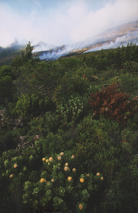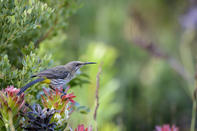Impressive Statistics

The Cape Peninsula is not as florally rich as the Hottentots Holland Mountain Range, yet its statistics are impressive: it is the size of the Isle of Wight, or half the size of New York City, and has more plant species than the entire British Isles (Table Mountain alone has some 2 500 recorded species).
Since the first of its plants (a blue sugar-bush, at first classified as a new species of thistle) was taken back to Europe by a Dutch sailor in 1597, the Cape's flora has impressed botanists and delighted gardeners the world over.
While human encroachment has stopped short of endangering the peninsula's fynbos component, it certainly has brought the once-extensive forests to the brink of extinction.
Dense Afro-montane forests, with giant yellowwoods (Podocarpus latifolius), white pear trees (Apodytes dimidiata), towering lichen-covered stinkwoods (Ocotea bullata red alders, spreading assegai trees (Curtisia dentata), Cape beech (Rapanea melanophloeos) and Cape holly (Ilex mitis) trees, once arched over singing rivers and fern-frilled glades.
First the forests of Hout Bay were plundered by shipbuilders; then, as the colony at the Cape grew, the demand for hardwood saw the forested slopes of Table Mountain flattened.
Away from the City

Still, a walk along the Contour Path, or any of the many paths that lead through Newlands Forest, reveals a magical sylvan world that leads one far away from the city's urban din. Although almost all of the Cape Peninsula's wild animals (lions, leopards, antelope, hippos, buffalos, and even migrant elephants) were not compatible with urban life, the birds remain.
The Cape fynbos is not known for its abundance of bird life, but Table Mountain has an impressive 150 recorded species. Orange-breasted sunbirds, Cape sugarbirds, red-winged starlings, rock pigeons, doves, grass birds and a few species of cisticola are the most common.
The most impressive, however, are the black eagles which soar the ridge winds, the white 'windows' on their wings, and crosses on their otherwise black backs flashing as they swoop and turn. Their diet consists almost exclusively of rock hyraxes (dassies), though in the Cape of Good Hope Nature Reserve, the small antelope which find sanctuary there help to vary the eagles' diets.
 Flower season in the Cape is something magical to behold - Experience the beauty of spring wild flowers on The Cape Flower Season Route....
Flower season in the Cape is something magical to behold - Experience the beauty of spring wild flowers on The Cape Flower Season Route....